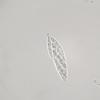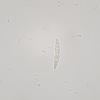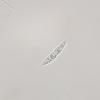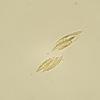
24-12-2025 17:08
Hulda Caroline HolteHello, I have found this propoloid ascomycete on

21-12-2025 09:32
Hello.A tiny ascomycete found embedded in wood in

21-12-2025 21:32
Pol DebaenstHello, Garden, Burgweg 19, Veurne, BelgiumOn 10/1

22-12-2025 23:38
Patrice TANCHAUDBonsoir, récolte sur un mur en pierre, apothéci

22-12-2025 00:47
Patrice TANCHAUDBonsoir, récolte à proximité du milieu dunaire
Gnomoniaceae on Betula leaves
Marcus Yeo,
15-08-2022 20:36
Details are as follows. Perithecia fully immersed; ca 600 µm diam.; with necks up to ca 1500 µm. Asci ca 45-55 x 12-16 µm; with prominent apical ring. Ascospores hyaline; fusiform; 1 -septate (septum median); constricted at septum; 22-25 x 3.5-4 µm; no appendages seen.
The ascospores seem to be too large for O. ischnostyla. For example, Sogonov et al. (2008) Studies in Mycology 62:1-79 give dimensions of (12.5–)13.5–15.5(–18.5) × (1.5–)2(–2.5) µm for O. ischnostyla. This corresponds with my experience of the species in the UK.
Monod's monograph of Gnomoniaceae contains Gnomonia betulina (synonym G. campylostyla) with ascospores 13-23 x 2.5-5 µm, which would fit with my collections. However, the spores are described as having appendages. G. betulina and/or G. campylostyla don't seem to be treated in Sogonov et al or in any other recent papers on Gnomoniaceae.
I'd be grateful for any help anyone can provide.
Thanks
Marcus
Alain GARDIENNET,
16-08-2022 10:53
Re : Gnomoniaceae on Betula leaves
Hi Marcus,
I observed for some species, that appendages could be sometimes present, or sometimes absent. Monod did same remarks :Gnomonia emarginata, one species close to G. betulina, is a good example. Perhaps is this more common at the end of maturity ?
So I think you're probably right.
Monod's work is the most complete for european species, and even if Sogonov and Walker have greatly advanced our knowledge of the Gnomoniaceae, and in particular the genus Ophignomonia, it may still be incomplete, especially as regards the european species. Therefore, Monod's work remains the best reference for the latter, and deserves to be completed by new studies. Donald Walker is no longer working on the Gnomoniaceae, there are not enough mycologists!
Gnomonia betulina is probably a poor known species ( a bit like Gnomonia kisslingii ion Quercus leaves). It would merit molecular studies. Please keep material in herbarium.
Best wishes,
Alain
I observed for some species, that appendages could be sometimes present, or sometimes absent. Monod did same remarks :Gnomonia emarginata, one species close to G. betulina, is a good example. Perhaps is this more common at the end of maturity ?
So I think you're probably right.
Monod's work is the most complete for european species, and even if Sogonov and Walker have greatly advanced our knowledge of the Gnomoniaceae, and in particular the genus Ophignomonia, it may still be incomplete, especially as regards the european species. Therefore, Monod's work remains the best reference for the latter, and deserves to be completed by new studies. Donald Walker is no longer working on the Gnomoniaceae, there are not enough mycologists!
Gnomonia betulina is probably a poor known species ( a bit like Gnomonia kisslingii ion Quercus leaves). It would merit molecular studies. Please keep material in herbarium.
Best wishes,
Alain
Marcus Yeo,
16-08-2022 11:57
Re : Gnomoniaceae on Betula leaves
Alain
Thank you for your response - that is very helpful.
I'm hoping to get the material into culture and get DNA analysis done.
Regards
Marcus
Thank you for your response - that is very helpful.
I'm hoping to get the material into culture and get DNA analysis done.
Regards
Marcus
Paul Cannon,
16-08-2022 12:41
Re : Gnomoniaceae on Betula leaves
I agree with Alain, presence of appendages in this group can be irregular. There are ITS sequences available of both G. betulina and G. emarginata contributed by the Sogonov group and blasting suggests that they are close but distinguishable. G. emarginata must also be a possible ID, I suspect that mounting media may influence spore dimensions (particularly width in elongated thin-walled spores). Hope the sequencing works well...
Best wishes
Paul
Lothar Krieglsteiner,
31-08-2022 10:35

Re : Gnomoniaceae on Betula leaves
Hello together,
I just tried to get the Monod paper via Internet but failed. Does somebody have? I would be interested.
Thanks and regards, Lothar
I just tried to get the Monod paper via Internet but failed. Does somebody have? I would be interested.
Thanks and regards, Lothar
Norbert Heine,
31-08-2022 20:13
Lothar Krieglsteiner,
31-08-2022 20:18

Re : Gnomoniaceae on Betula leaves
Hallo Nobi,
vielen Dank für den Link - klasse!
LG von Lothar
vielen Dank für den Link - klasse!
LG von Lothar




